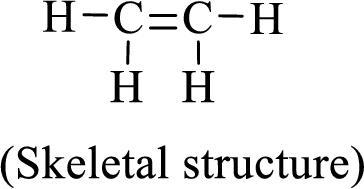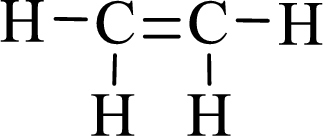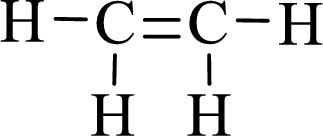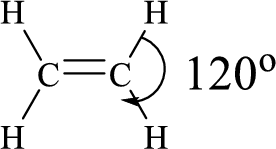
Concept explainers
- a. Draw the Lewis structure for ethene (ethylene), H2CCH2, a small hydrocarbon with a
 double bond.
double bond. - b. Based on this structure, predict the H–C–H bond angle. Explain your reasoning.
- c. Sketch the molecule showing the predicted bond angles.
(a)
Interpretation:
The Lewis structure for ethylene has to be drawn.
Concept Introduction:
Lewis structures are diagrams that represent the chemical bonding of covalently bonded molecules and coordination compounds.
The chemical bonding present in covalently bonded molecules and in coordination compounds are represented using Lewis structures.
It is also known as Lewis dot structures which represents the bonding between atoms of a molecule and the lone pairs of electrons that may exist in the molecule.
The Lewis structure is based on the concept of the octet rule so that the electrons shared in each atom should have 8 electrons in its outer shell.
Sometimes the chemical bonding of a molecule cannot be represented using a single Lewis structure. In these cases, the chemical bonding are described by delocalization of electrons and is known as resonance.
All the possible resonance structures are imaginary whereas the resonance hybrid is real.
These structures will differ only in the arrangement of the electrons not in the relative position of the atomic nuclei.
Lewis structure for any molecule is drawn by using the following steps,
First the skeletal structure for the given molecule is drawn then the total number of valence electrons for all atoms present in the molecule is determined
The next step is to subtract the electrons present in the total number of bonds present in the skeletal structure of the molecule with the total valence electrons such that considering each bond contains two electrons with it.
Finally, the electrons which got after subtractions have to be equally distributed such that each atom contains eight electrons in its valence shell.
Molecular geometry is the shape of a molecule predicted by considering only bond pair of electrons.
Geometry of different type of molecules with respect to the number of electron pairs are mentioned below,
Explanation of Solution
The Lewis electron dot structure for given molecules are determined by first drawing the skeletal structure for the given molecules, then the total number of valence electrons for all atoms present in the molecules are determined.
The next step is to subtract the electrons present in the total number of bonds present in the skeletal structure of the molecule with the total valence electrons such that considering each bond contains two electrons with it.
Finally, the electrons which got after subtractions have to be equally distributed considering each atom contains eight electrons in its valence shell.
The given moleucle is ethylene

Thus, the Lewis structure of given compound is,

(b)
Interpretation:
The bond angle value in
Concept Introduction:
Molecular geometry is the shape of a molecule predicted by considering only bond pair of electrons.
Geometry of different type of molecules with respect to the number of electron pairs are mentioned below,
Explanation of Solution
Lewis structure for the given compound ethylene is,

Here, the carbon atom does not have lone pair of electrons and the geometry around the carbon atom is triogonal planar, thus the bond angle in between
(c)
Interpretation:
The ethylene molecule has to be sketched and the predicted bond angle should be shown in the structure.
Concept Introduction:
Molecular geometry is the shape of a molecule predicted by considering only bond pair of electrons.
Geometry of different type of molecules with respect to the number of electron pairs are mentioned below,
Explanation of Solution
Lewis structure for the given compound ethylene is,

Here, the carbon atom does not have lone pair of electrons and the geometry around the carbon atom is triogonal planar, thus the bond angle in between
According to the predicted bond angle the structure can be sketched as follows,

Want to see more full solutions like this?
Chapter 4 Solutions
Chemistry In Context
Additional Science Textbook Solutions
Chemistry & Chemical Reactivity
CHEMISTRY-TEXT
Inorganic Chemistry
Inorganic Chemistry
Chemistry: Matter and Change
Principles of General, Organic, Biological Chemistry
- hat is meant by the term driving forces? Why are mailer spread and energy spread considered to be driving forces?arrow_forward1.You have made structures of NH3 and H2CO molecules in the Part A of your lab report.Both NH3 and H2CO molecules have three electron groups around the central atom.However, their molecular geometries are not the same. Explain this difference. 2. Draw the Lewis electron dot structure for SCl2 and discuss its molecular geometry. IsSCl2 molecule polar or nonpolar? Explain your answer.arrow_forwardAtom A has 4 valence electrons. Atom Z has 6 valence electrons. For the AZ3-2 ion How many valence electrons are in the structure? b. How many single bonds are in the structure? c. How many double bonds are in the structure? d. How many triple bonds are in the structure? e. How many lone pairs are on the central atom in the structure? f. What is the shape of the structure? g. What are the bond angles of this ion?arrow_forward
- 13. An instructor gave you direction to construct a model of CH3CH2Br molecule by following the Experimental Procedure section of your experiment. What do you think is the geometry of this model? 14. An instructor gave you directions to construct a model of the CH3CH2Br molecule by following the Experimental Procedure section of your experiment. Is this molecule polar or non-polar? 15. An instructor gave you directions to construct a model of the CH3CH2Br molecule by following the Experimental Procedure section of your experiment. Would you expect this molecule to have any isomeric forms? 16. An instructor gave you directions to construct a model of the CH3CH2Br molecule by following the Experimental Procedure section of your experiment. Would you expect this molecule to have any resonance structures?arrow_forwarda Carbonyl fluoride, COF2, is an extremely poisonous gas used in organofluorine synthesis. Give the valence bond description of the carbonyl fluoride molecule. (Both fluorine atoms are attached to the carbon atom.) b Nitrogen, N2, makes up about 80% of the earths atmosphere. Give the valence bond description of this molecule.arrow_forwardYou will not find “hydroxide” in the stockroom, but you will find sodium hydroxide (NaOH) andpotassium hydroxide (KOH). Lithium hydroxide (LiOH) is expensive and used in spacecraft airfilters since hydroxide reacts with carbon dioxide, and lithium is lighter than sodium or potassium.Cesium and francium hydroxides are very expensive and little used. Is this information consistentwith your answer to the previous question?arrow_forward
- Explain why the actual angles in SCl4 differ from the offical angles. Suggest realistic actual angle values.arrow_forwardWhich will have the lowest Bp? 1. Ne 2. Ar 3. He 4. Krarrow_forward3. Complete the following for the formula PCl2I (there is only 1 central atom). Draw a plausible Lewis Structure. Name the electron geometry associated with your structure above. Name the molecular shape associated with your structure above. Draw a 3D representation of your structure including approximate bond angles. Would your structure be polar or nonpolar? Be sure to show or explain how you determined this.arrow_forward
- Part A) Consider the structural changes that occur in the following molecules. Begin by drawing the best Lewis Structure for each of the following molecules. BH3 CH4 NH3 H2O HF Part B)What are the ideal bond angles for each structure, and which are expected to be distorted? For the ones that are distorted look up on the internet and record their experimental values here: Part C)According to Lewis and VSEPR theory, why do these changes occur?arrow_forwardPropylene, C3H6,C3H6, is a gas that is used to form the important polymer called polypropylene. Its Lewis structure is (a) What is the total number of valence electrons in the propylene molecule? (b) How many valence electrons are used to make σσ bonds in the molecule? (c) How many valence electrons are used to make ππ bonds in the molecule? (d) How many valence electrons remain in nonbonding pairs in the molecule? (e) What is the hybridization at each carbon atom in the molecule?arrow_forwardHi,Can you help me find 1. The bond type on carbon for chloroethane. 2. The bond type and bond angle on carbon for Dichloroethane please.arrow_forward
 Organic Chemistry: A Guided InquiryChemistryISBN:9780618974122Author:Andrei StraumanisPublisher:Cengage Learning
Organic Chemistry: A Guided InquiryChemistryISBN:9780618974122Author:Andrei StraumanisPublisher:Cengage Learning Chemistry & Chemical ReactivityChemistryISBN:9781337399074Author:John C. Kotz, Paul M. Treichel, John Townsend, David TreichelPublisher:Cengage Learning
Chemistry & Chemical ReactivityChemistryISBN:9781337399074Author:John C. Kotz, Paul M. Treichel, John Townsend, David TreichelPublisher:Cengage Learning Chemistry & Chemical ReactivityChemistryISBN:9781133949640Author:John C. Kotz, Paul M. Treichel, John Townsend, David TreichelPublisher:Cengage Learning
Chemistry & Chemical ReactivityChemistryISBN:9781133949640Author:John C. Kotz, Paul M. Treichel, John Townsend, David TreichelPublisher:Cengage Learning Living By Chemistry: First Edition TextbookChemistryISBN:9781559539418Author:Angelica StacyPublisher:MAC HIGHER
Living By Chemistry: First Edition TextbookChemistryISBN:9781559539418Author:Angelica StacyPublisher:MAC HIGHER Introductory Chemistry: A FoundationChemistryISBN:9781337399425Author:Steven S. Zumdahl, Donald J. DeCostePublisher:Cengage LearningChemistry: Matter and ChangeChemistryISBN:9780078746376Author:Dinah Zike, Laurel Dingrando, Nicholas Hainen, Cheryl WistromPublisher:Glencoe/McGraw-Hill School Pub Co
Introductory Chemistry: A FoundationChemistryISBN:9781337399425Author:Steven S. Zumdahl, Donald J. DeCostePublisher:Cengage LearningChemistry: Matter and ChangeChemistryISBN:9780078746376Author:Dinah Zike, Laurel Dingrando, Nicholas Hainen, Cheryl WistromPublisher:Glencoe/McGraw-Hill School Pub Co





